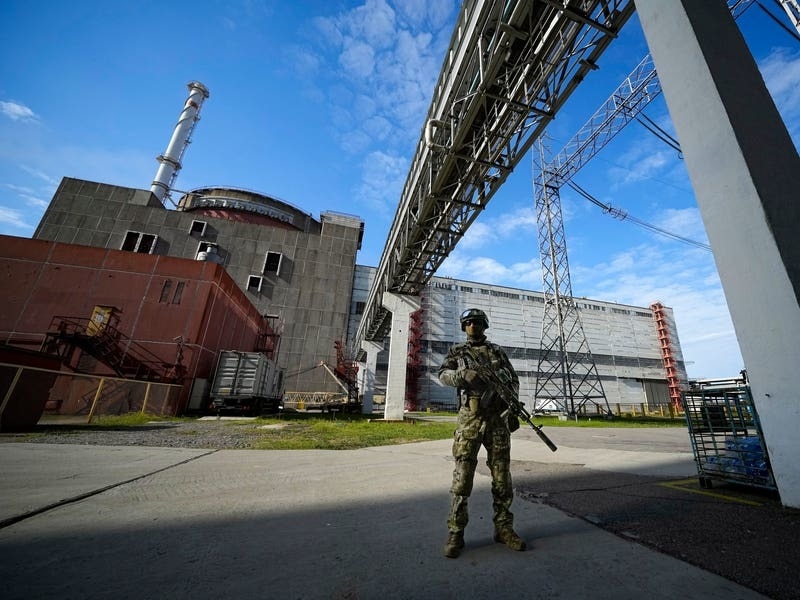The head of the United Nations’ nuclear watchdog has expressed growing concern about the safety of the Zaporizhzhia nuclear power station, after the governor of the Russia-occupied area ordered the evacuation of a town where most of the plant’s staff live amid ongoing attacks in the area.
The plant is near the front lines of fighting, and Ukrainian authorities said on Sunday that a 72-year-old woman was killed and three other people injured when Russian forces fired more than 30 shells at Nikopol, a Ukrainian-held town close to the plant.
“The general situation in the area near the Zaporizhzhya nuclear power plant is becoming increasingly unpredictable and potentially dangerous,” International Atomic Energy Agency head Rafael Grossi said in a warning on Saturday, before the latest report of attacks.
“I’m extremely concerned about the very real nuclear safety and security risks facing the plant.”
Director General @rafaelmgrossi said evacuation of residents at Enerhodar, where most of staff from #Ukraine’s #Zaporizhzhya Nuclear Power Plant live, has started. @iaeaorg is closely monitoring for any potential impact on nuclear safety and security.https://t.co/RvzRP8WL46 pic.twitter.com/BWuUbbcWxY
— IAEA – International Atomic Energy Agency ⚛️ (@iaeaorg) May 6, 2023
Mr Grossi’s comments were prompted by an announcement on Friday by Yevgeny Balitsky, the Russian-installed governor of the partially-occupied Zaporizhzhia province, that he had ordered the evacuation of civilians from 18 settlements in the area, including Enerhodar, which is located next to the power plant, which is Europe’s largest.
The settlements affected are 30-40 miles (50-70km) from the front line of fighting between Ukraine and Russia, and Mr Balitsky said Ukraine has intensified attacks on the area in the past several days.
The region is also widely seen as a likely focus for Ukraine’s anticipated spring counter-offensive.
Some of the fiercest ongoing fighting is in the eastern city of Bakhmut, where Ukrainian forces are still clinging to a position on the western outskirts despite Russia trying to take the city for more than nine months.
Russian Defence Ministry spokesman Igor Konashenkov said on Sunday that Moscow’s forces had captured two more districts in the city’s west and north-west, but provided no further details.
Latest Defence Intelligence update on the situation in Ukraine – 7 May 2023.
Find out more about Defence Intelligence’s use of language: https://t.co/RwUoR1noSV
?? #StandWithUkraine ?? pic.twitter.com/dpkV4CyZVP
— Ministry of Defence ?? (@DefenceHQ) May 7, 2023
Ukraine’s Special Operations Forces on Saturday accused Russia of using phosphorous in the city and on Sunday released a new video showing the tell-tale white fire from such munitions.
International law prohibits the use of white phosphorus or other incendiary weapons – munitions designed to set fire to objects or cause burn injuries – in areas where there could be concentrations of civilians, though it can also be used for illumination or to create smoke screens.
It was not possible to independently verify where the video was shot or when, but chemical weapons expert Hamish de Bretton-Gordon, a former British army colonel, said it was clearly white phosphorous.
“This is being fired directly at Ukraine positions and this would be a war crime,” he said.
“I expect because the Russians have failed to take Bakhmut conventionally, they are now using unconventional tactics to burn the Ukrainian soldiers to death or to get them to flee.”

In a Telegram post on Sunday, the aide to the exiled Ukrainian mayor of the Russia-occupied coastal city of Mariupol said that there was evidence that Moscow’s forces had intensified their transfer of tracked vehicles through the city and into the frontline Zaporizhzhia region.
Petro Andryushchenko claimed that more and more vehicles were being spotted crossing the city “every day”.
He posted a short video showing heavy trucks transporting armoured vehicles along a road, without specifying where or when it was taken.

According to an update posted on Facebook, the General Staff said the first residents being moved are those who took Russian citizenship following the capture of the town by Moscow early in the war.
They are being taken to the Russia-occupied Azov Sea coast, about 120 miles (200km) to the south-east.
Mr Grossi said operating staff at the nuclear power plant, whose six reactors are currently all in shutdown mode, had not been evacuated as of Saturday but that most live in Enerhodar and the situation has contributed to “increasingly tense, stressful and challenging conditions for personnel and their families”.
He added that IAEA experts at the nuclear site “are continuing to hear shelling on a regular basis”.
“We must act now to prevent the threat of a severe nuclear accident and its associated consequence for the population and the environment,” Mr Grossi said.

Elsewhere, Russian shelling on Saturday and overnight killed six civilians and injured four others in Ukraine’s southern Kherson region, according to a Telegram update published by the local administration on Sunday.
Five civilians were injured in the eastern Donetsk region, the epicentre of the fighting in recent months, local governor Pavlo Kyrylenko reported on Sunday morning.
Meanwhile, Ukrainian forces overnight attacked the largest port in the Russia-occupied Crimean Peninsula with drones, a Kremlin-installed local official said on Telegram early on Sunday.
According to the post by Mikhail Razvozhayev, the governor of Sevastopol, 10 Ukrainian drones targeted the city, three of which were shot down by air defence systems. Mr Razvozhayev said there had been no damage.






